2023 Annual Report
Rodenticides in Raptors Study:
We Did It. YOU Did It.
We completed our five-year collaboration with PAWS Wildlife Center on exposure to anticoagulant rodenticides in urban raptors in western Washington. We tested tissue from 277 dead raptors of 15 species: bald eagle, red-tailed hawk, three accipiters (Cooper’s hawk, sharp-shinned hawk, American goshawk), two falcons (peregrine, merlin), and eight owl species (barred, great horned, barn, western screech, Northern saw-whet, great gray, short-eared, and Northern pygmy-owl). Anticoagulant rodenticides (ARs) were found in over 85% of 11 raptor species, and most samples had two or more ARs. Our results are consistent with and expand findings from other studies of rodenticides in North American raptors. In October, Patti Loesche presented the results at the annual meeting of the Raptor Research Foundation in Albuquerque. We’ll next submit this study for publication.
This was the first survey of rodenticides in raptors in Washington State. It was expensive (over $40,000) and time-intensive. We could not have accomplished this work without enormous support from the PAWS vet team and many donors. Our heartfelt thanks to you all—you did it!
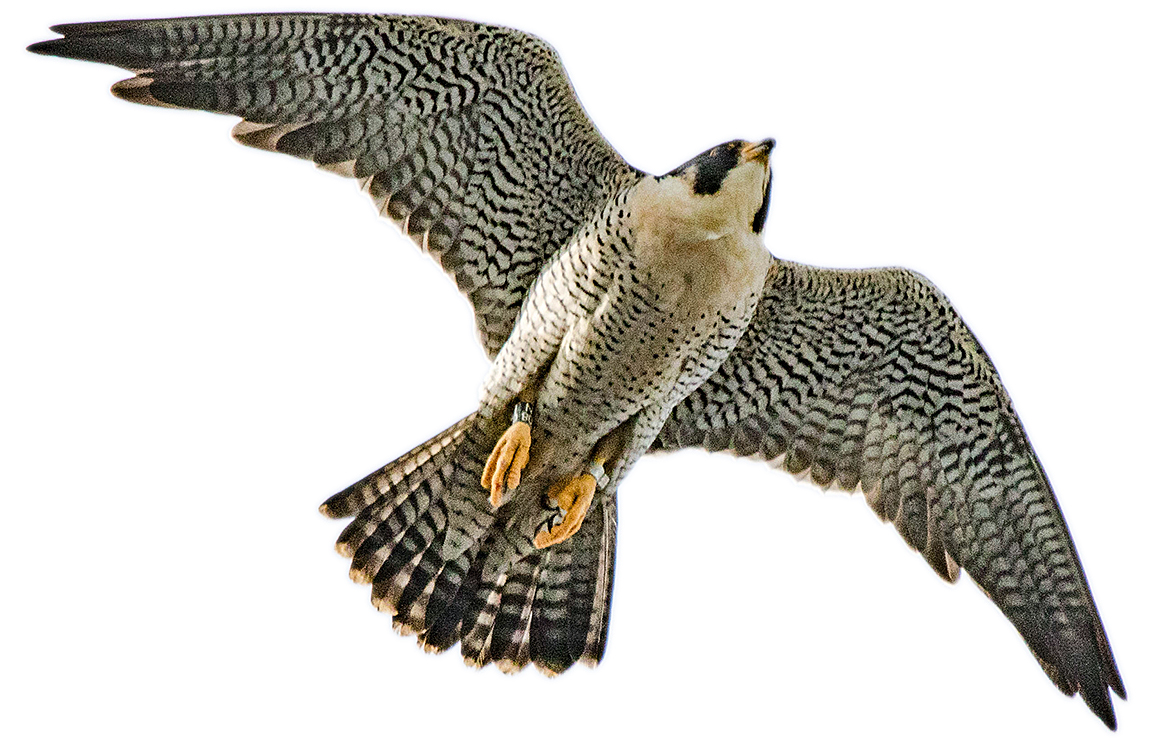
Long-time resident male peregrine “Murray” in downtown Tacoma (Fergus Hyke)
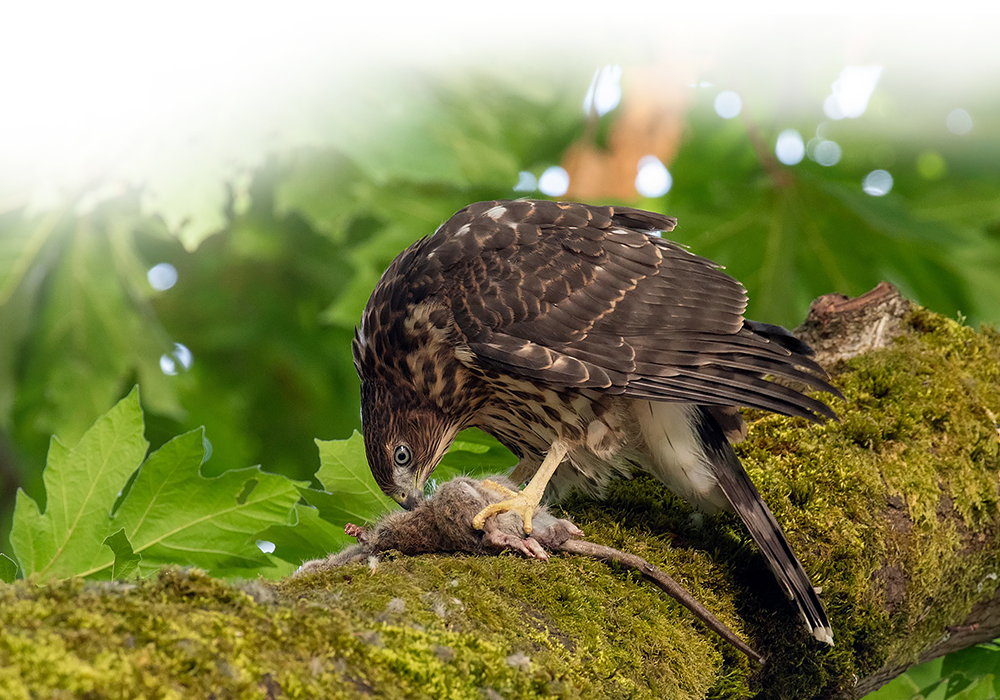
Cooper’s hawk fledgling with rat (John Gossman)
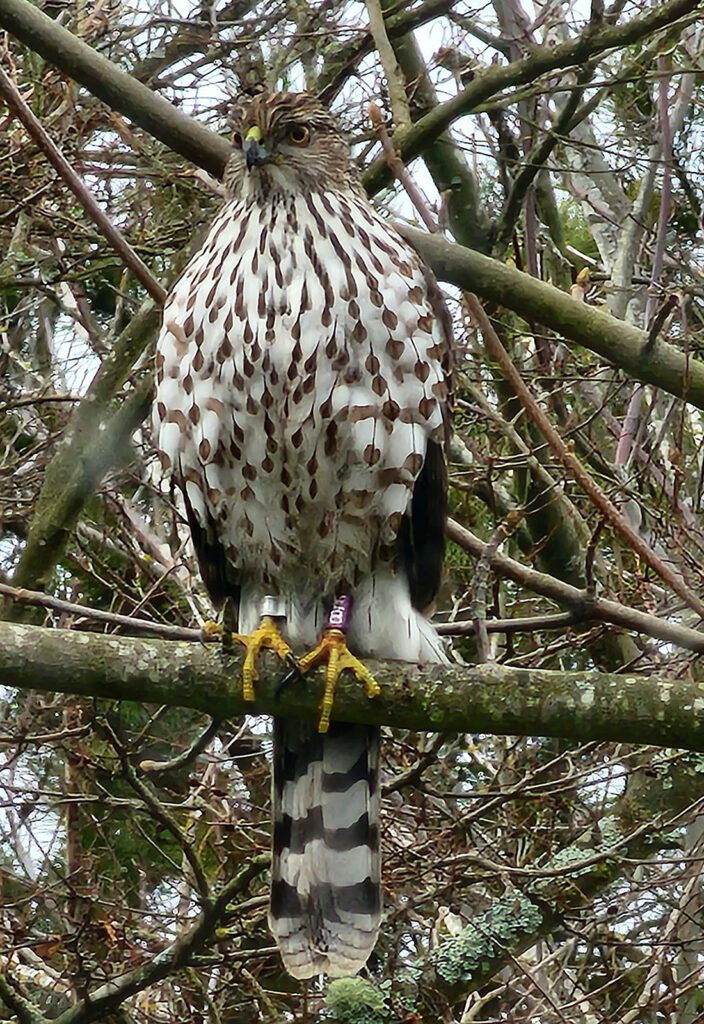
Male Cooper’s hawk purple left E-8, banded in Seattle in July 2022 as a fledgling and seen about a mile away in February 2023 (Jeff Vittone)
Long-term Monitoring Studies
Seattle Cooper’s Hawk Study. Coop volunteers located 66 nest-building pairs, and 55 pairs fledged 200 young—all record numbers. After a slight downturn in fledgling numbers in 2022, we once again found a growing population. Urban Cooper’s hawks like the Seattle Parks system: 40 of the nests were in parks. How many more Coop pairs can the city support? Read our annual report on the Seattle Cooper’s Hawk Study here.
Puget Sound Peregrine Project. Volunteers followed 11 peregrine sites: five in Seattle, three in Tacoma, and three in the Cascade foothills (special thanks to the tireless Roger Orness). Four of the urban sites failed. High fledgling mortality, although expected, is the hardest part of the peregrine volunteer gig. But there were happy outcomes too: successful fledging in Seattle from 1201 3rd Ave, AGC, and West Seattle Bridge (with a few side trips to PAWS Wildlife Center) and in Tacoma from the Bradken Foundry. The three wild eyries also successfully fledged all 10 young.
The long-resident male in downtown Tacoma (“Murray”), banded in 2004 by Bud Anderson, died of his injuries in a territorial fight in late spring (the winner of that battle is the new resident male). At 19 years, Murray was the fourth-oldest known wild peregrine in North America.
AGC mounted the city’s second falcon cam, and the original falcon cam at 1201 3rd Ave. was replaced this past year, with a gratifying improvement in image clarity. Two falcon cams! At Patagonia 1st Ave, the store team mounted iPads with live views from both cameras. What a fantastic opportunity to compare these two local sites.
Read our annual report on the Puget Sound Peregrine Project here.
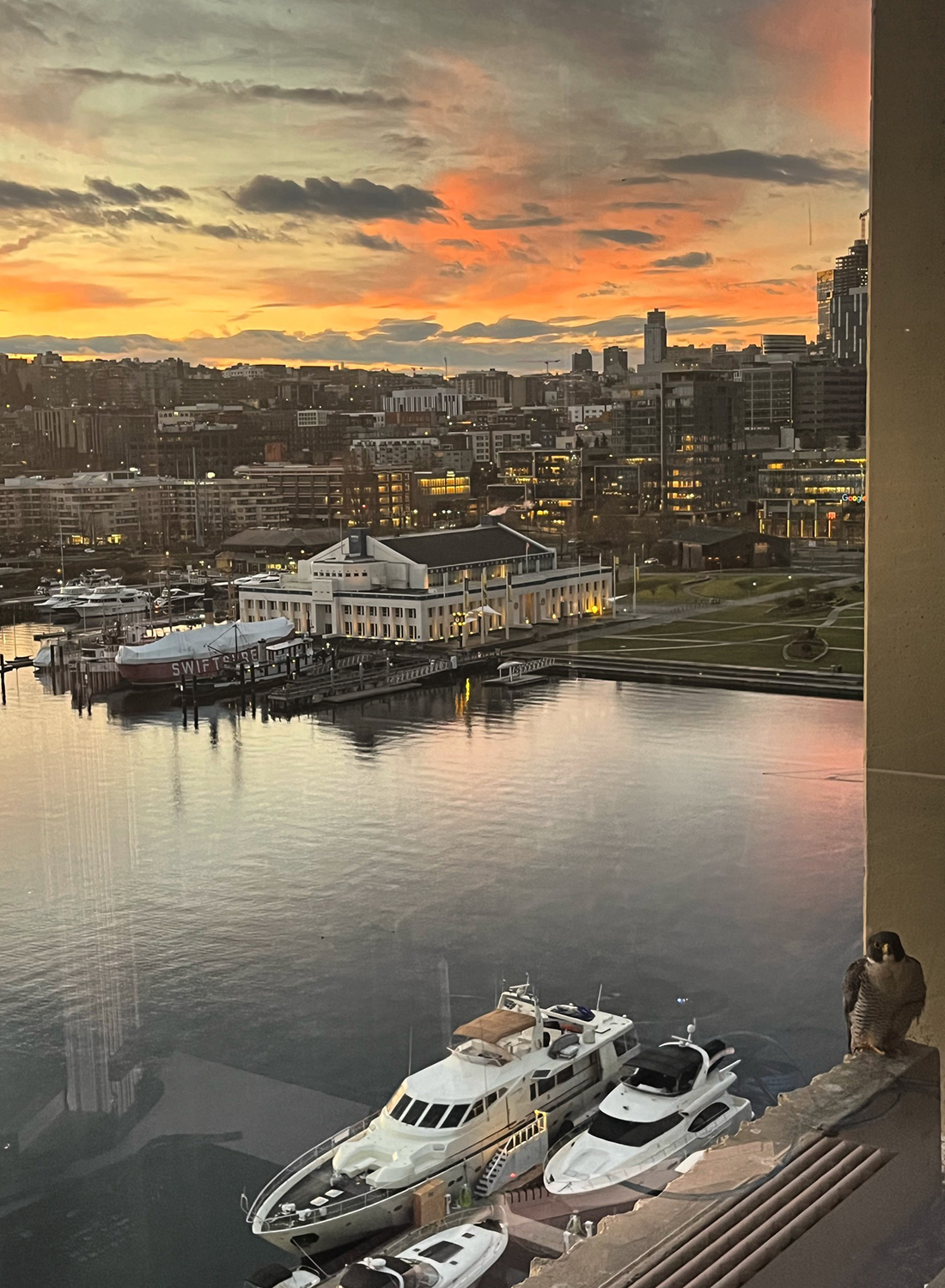
Adult male peregrine near his eyrie at AGC on South Lake Union in March 2023 (Anne Hilton)
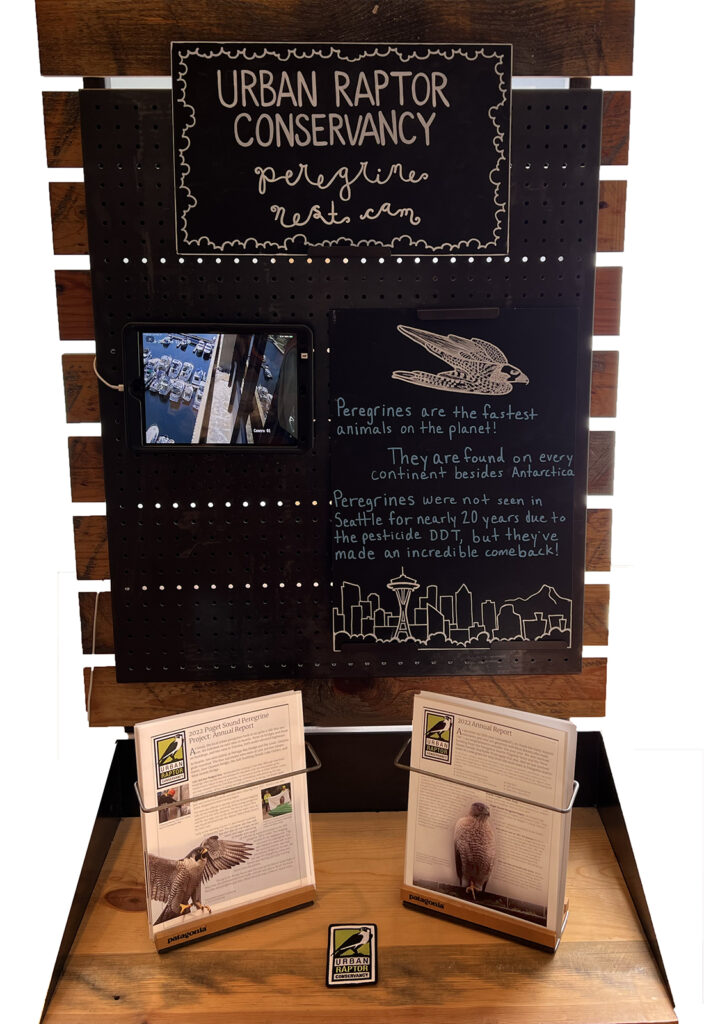
Right: Patagonia store display with live feed of peregrine eyrie at AGC on South Lake Union (Denis Tuzinovic)
Seattle Merlin Project. We followed the breeding activity of 17 merlin pairs in greater Seattle and assisted in the release of a rehabilitated juvenile at one site. Nest site density seems to be increasing since we found and started monitoring the region’s merlins in 2013, and we will continue to monitor this.
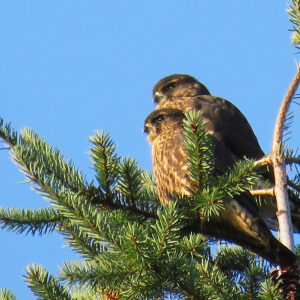
Fledgling male (front, smaller) and female merlin siblings await their evening meal delivery (Kim McCormick)
Rehabbed Bald Eagle Featured on PBS. Mutual of Omaha’s Wild Kingdom, which many of us old-timers grew up watching, returned to the airwaves this year, now focusing on success stories in wildlife conservation. Wild Kingdom recently featured an adult female bald eagle that had been shot. After surgery and rehabilitation at PAWS, she was banded by URC and successfully released. PAWS vet Nicki Rosenhagen is interviewed, and URC’s green and black VID band (8-P) makes a cameo appearance in this 6-minute video.
Color-Band Studies
We band raptors and record future sightings of banded birds to learn more about their dispersal and fates. Banding only matters if the birds are seen again. Thank you, indispensable observers, for enriching our knowledge of these raptors through your band sightings. Under Ed Deal’s master banding permit, coded color-ID (“VID”) bands have been placed on Seattle Cooper’s hawks, Puget Sound peregrines, and merlins, as well as on rehabbed bald eagles and barred owls at PAWS.
In 2023, 79 Cooper’s hawks received VID bands, 59 of them fledglings. Since 2012, 46% of 556 banded Coops from our study have been spotted and reported to us, a spectacular rate of return. We banded seven fledgling peregrines: two wayward youngsters PAWS, and five nestlings banded at their respective eyries at 1201 3rd Ave and AGC.
At PAWS. we banded 50 rehabilitated raptors in 2023 and have banded over 300 since 2020. In addition to putting VID bands on rehabbed Coops, peregrines, and merlins at PAWS last year, we also banded 10 bald eagles and 16 barred owls. Of the 55 bald eagles banded since 2020, we have received band returns for 10 (18%) of them. No band sightings yet for the barred owls, all banded in 2023.
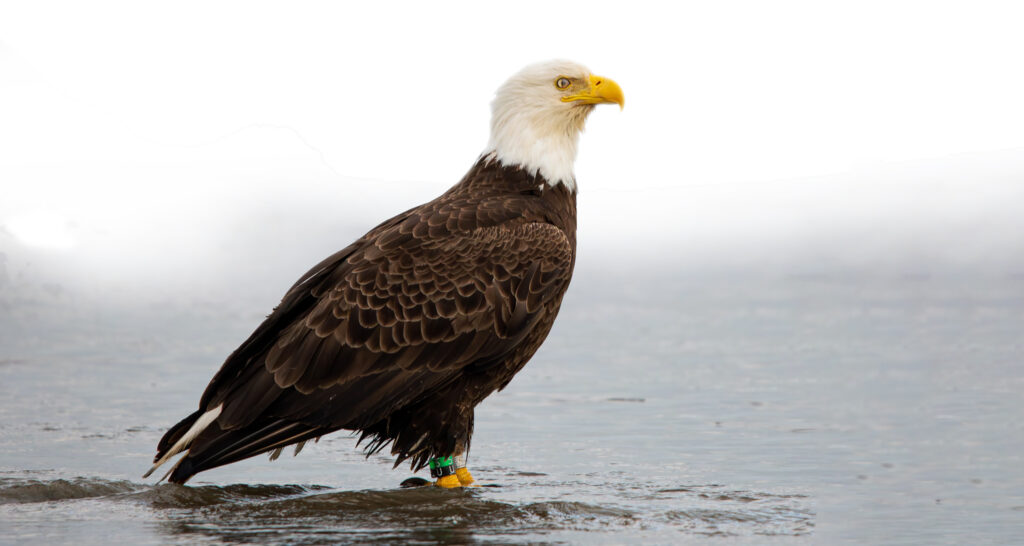
This adult female bald eagle was injured in a territorial fight in April 2022. She was rehabilitated at PAWS, banded 5-U, and released back on the Long Beach Peninsula in May 2022. She has been seen on the coast several times since, including in this photo from May 2023. (Barry Griffith)
Volunteer Passages
Jenn Kovach. URC was strengthened this year by the addition of Jenn Kovach as our new field volunteer coordinator. Jenn has been a peregrine and Coop steward for several years, and thanks to her early-morning vigils she holds the volunteer record for plucking peregrine fledglings out of trouble. Now she also smooths the way for our volunteer team.
Penny Lewis. We mourn the passing of Penny Lewis, a long-time volunteer, URC supporter, and friend. The Cooper’s hawk and peregrine projects will be poorer without her experienced observations and field assistance.
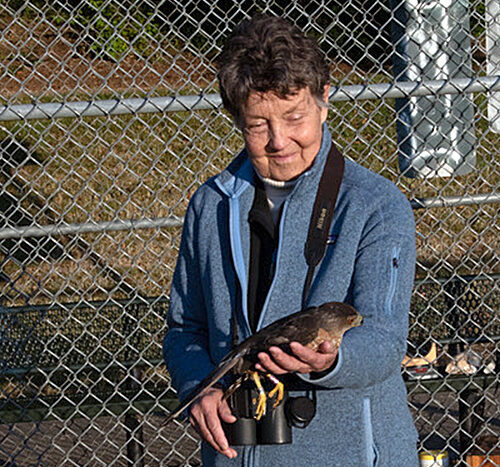
Penny Lewis (Martin Muller)
Other Raptors
We often get queries about the status of other raptors in our region—ospreys, red-tailed hawks, bald eagles, owls. We don’t track these species, but if you’re interested, do it! The world is changing for them, too, and we have much to learn by paying attention.
Thank You, Patagonia!
Once again, the team at Patagonia’s downtown store awarded URC a $10,000 grant. We are very proud of our affiliation with Patagonia, and especially proud of receiving this local recognition from the store staff. Patagonia has had our back and shared our passion for urban raptors since the beginning.
Thank You, Everybody!
Now in our sixth(!) year, 2023 brought us the return of many stalwarts along with new volunteers, donors, and donations. We are warmed by the fellowship of raptor watchers that we have discovered through our little organization and humbled by all of this support that enables us to keep going.
If you’re reading this report, you care about our urban raptors and are part of our URC community. However you support us, thank you for being with us. The beginning of the year is a time for hope, even in challenging times. Here’s to 2024, and here’s to the raptors!
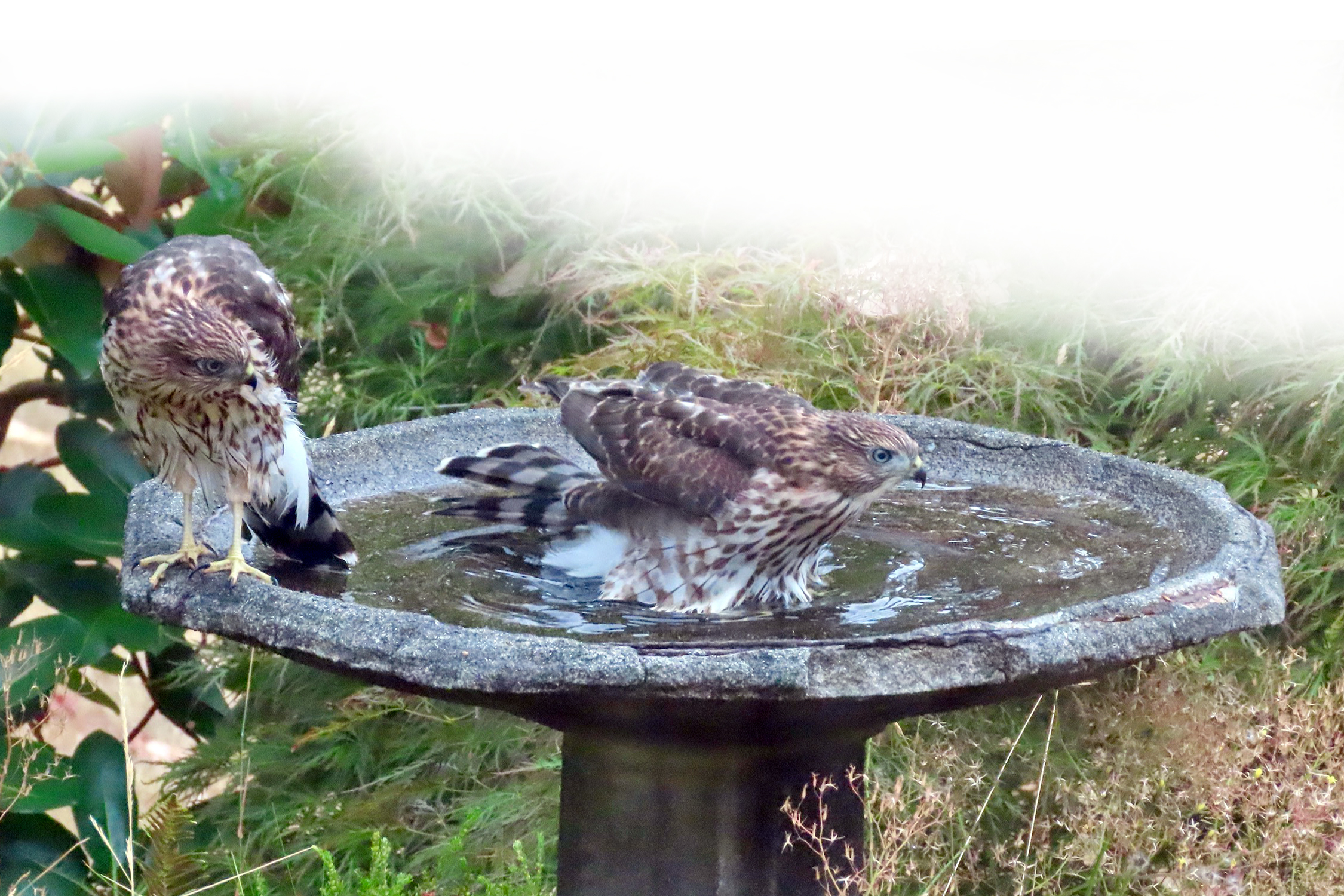
(Vlad Oustimovitch)